Shopify vs Teespring, which solution should you be using for your business?
It might seem like a simple question, but it’s not a like-for-like comparison. Shopify is a comprehensive commerce platform, designed to help businesses create and run various types of companies, from service-based businesses to ecommerce stores.
Teespring, on the other hand, is a simple print-on-demand solution, intended to help members of the creator economy, and would-be retailers design and sell custom products.
Here’s what you need to know to make the right choice between the two options.
To make the right choice between Shopify and Teespring, you first need to know what each solution actually offers.
Quick Verdict: Pros and Cons
TL;DR: If you need a comprehensive ecommerce platform with extensive customization options and the flexibility to sell any type of product, Shopify is your best choice.
However, if you're a content creator looking for a simple print-on-demand solution with built-in marketplace access and no upfront costs, Teespring (now Spring) offers a more streamlined approach.
Shopify Pros and Cons
Pros:
- Comprehensive ecommerce platform with extensive features
- 120+ customizable themes with industry-specific designs
- Powerful SEO tools and analytics
- Extensive app marketplace for additional functionality
- Multiple sales channels including POS integration
- Built-in marketing and automation tools
- Flexible payment processing options
- Advanced inventory and order management
- 24/7 customer support with phone option
Cons:
- Monthly subscription fees required ($32-$399+)
- Can be complex for beginners
- Premium themes cost $200-$500
- Additional costs for apps and integrations
- Standard credit card fees (2.9% + $0.30)
- Steeper learning curve
- More setup time required
Teespring (Spring) Pros and Cons
Pros:
- No upfront costs or monthly fees
- Built-in print-on-demand services
- Access to established marketplace
- Simple, streamlined interface
- No payment processing fees on physical products
- Easy setup process
- Handles fulfillment and customer service
- 50+ customizable products
- Built-in order tracking
Cons:
- Limited website customization (one template)
- High digital product fees (10% + $0.40)
- Basic SEO capabilities
- Limited branding options
- Restricted to print-on-demand products
- Limited customer support hours
- Less control over pricing and margins
- No phone support
Quick Comparison: Shopify vs Teespring
Primary Use Case
- Shopify: Full-featured ecommerce platform for any type of business
- Teespring: Specialized print-on-demand platform for creators
Target Users
- Shopify: Business owners needing comprehensive ecommerce solutions
- Teespring: Content creators and influencers selling merchandise
Learning Curve
- Shopify: Moderate to High; extensive features require time to master
- Teespring: Low; simplified interface focused on quick setup
Price Structure
- Shopify: Monthly subscriptions with standard transaction fees
- Teespring: No monthly fees, free until you make sales
Ideal For
- Shopify: Businesses wanting full control over their online presence
- Teespring: Creators needing simple merchandise creation and fulfillment
What is Shopify?
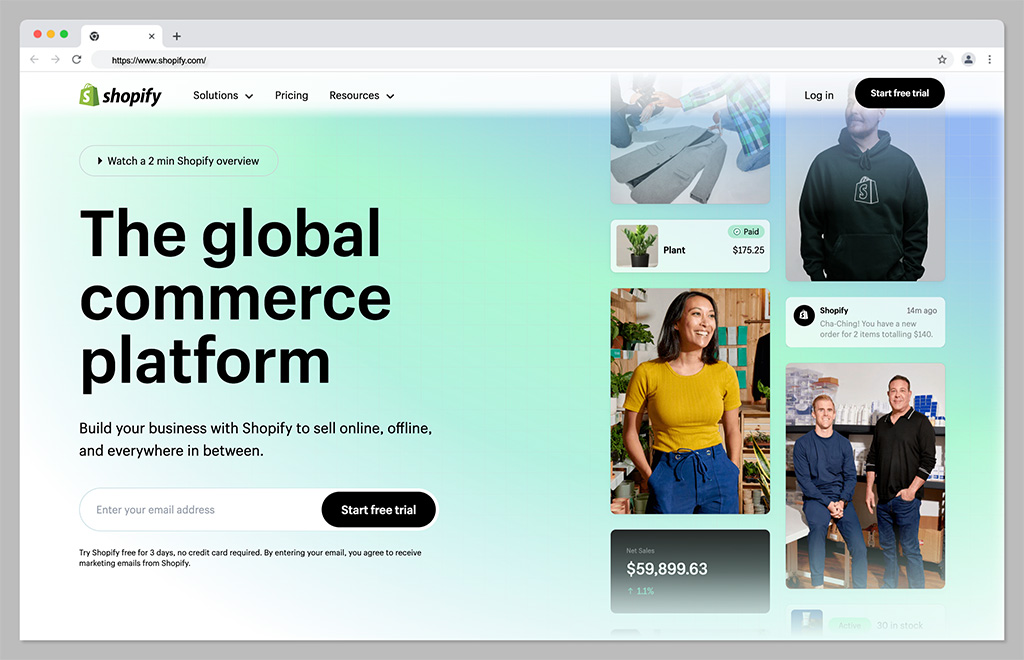
Shopify is a SaaS (Software as a Service) commerce platform. Business owners can use the service to build a website or ecommerce store, and sell products, services, or digital items.
Shopify supports virtually any kind of business model. You can leverage Shopify’s “POS” (Point of Sale) tools to synchronize your offline sales with your online store.
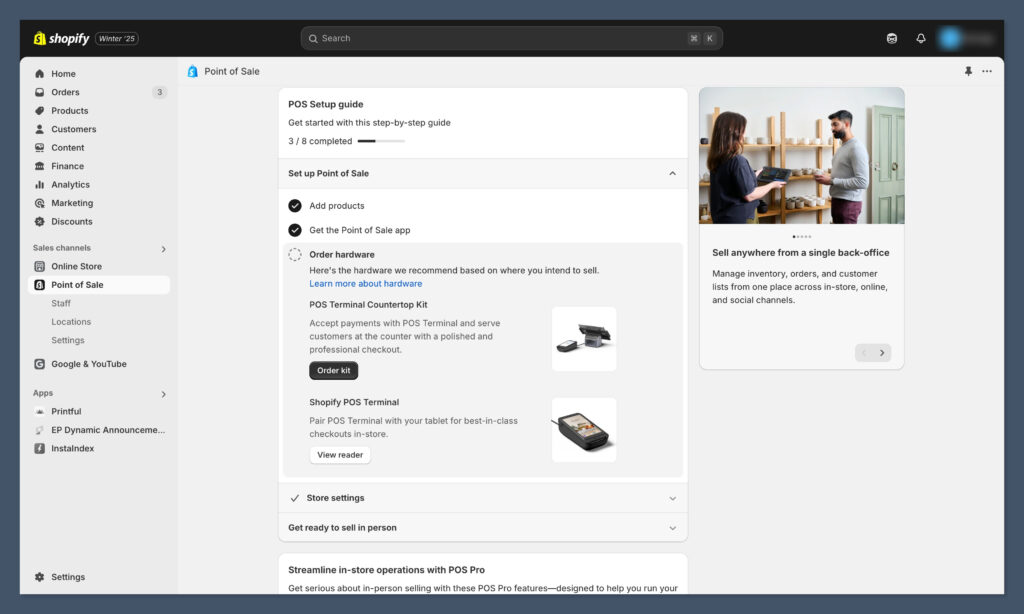
Business owners can manage bookings on Shopify for service clients, sell digital downloads, or even integrate POD and dropshipping apps like Teespring to minimize the stress of handling logistics.
Shopify comes with everything you need to run and grow your business, from an integrated payment processor, to content marketing tools (SEO and blogging), email marketing integrations, social media solutions, and inventory and order management features.
As one of the most popular ecommerce platforms on the market, Shopify isn’t exactly a direct competitor to Teespring. However, you can use Shopify to achieve the functionality provided by Teespring, like:
- Turning your creative ideas into products
- Selling physical and digital products
- Making and selling print-on-demand merchandise
- Selling on social channels
- Launching an online store
- Printing and fulfilling products through the platform (print-on-demand)
You’ll learn how Teespring is a print-on-demand fulfillment service for creators (with other elements like social selling and a marketplace for listing products).
Shopify is much more than that. You can customize every aspect of your Shopify store, sell on marketplaces like eBay and Amazon, list products in different geographical markets, install apps, and complete your fulfillment (or partner with third-party logistics companies).
So, Shopify may seem like it’s all too much if you’re simply trying to create merchandise and have it printed and fulfilled by another company.
Or, you may find that Shopify is a more flexible system that gives you increased control over your creator merchandise.
What is Teespring?
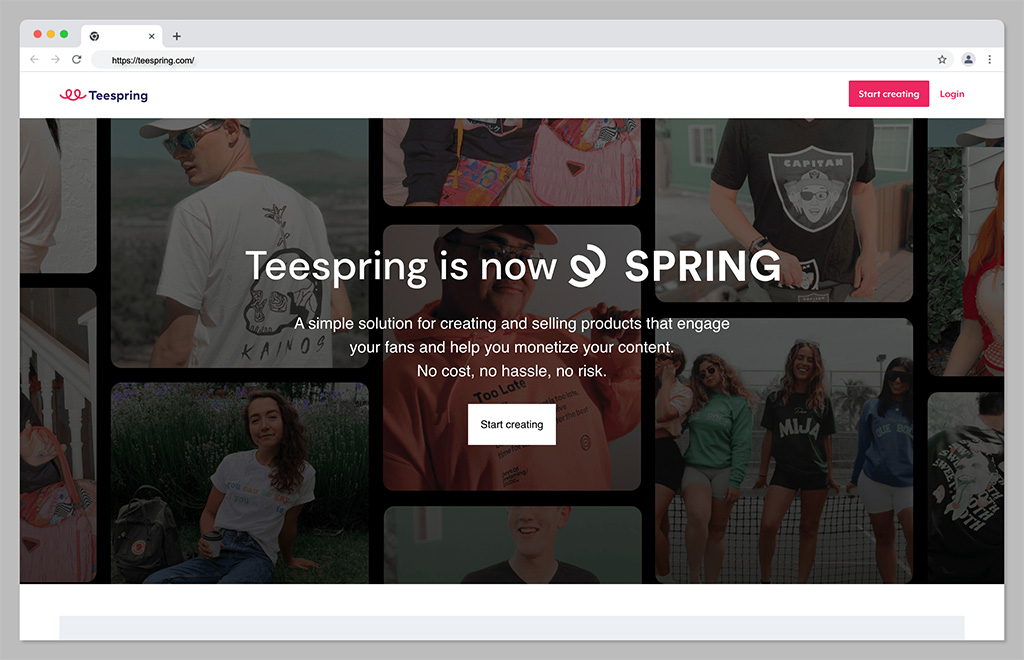
Teespring (Now Spring) is a free-to-use “social commerce” platform, which supports companies and creators embracing the “print on demand” model.
With Spring, you can create and sell over 50 kinds of products, adding your own custom designs to white label shirts, canvas bags and more.
The Teespring platform simplifies everything from product creation to order fulfillment and customer service, with built-in order tracking tools, and inventory management solutions. Plus, the platform comes with selling tools such as promotional codes to help maximize your sales.
Spring comes with its own marketplace environment, where you can list products alongside other sellers. Like other POD leaders, Teespring handles the fulfillment and production process on the behalf of users, creating items, and shipping them to customers through logistics partners.
Interestingly, Teespring also allows you to create your own online store, with a custom domain, similar to Shopify. Plus, you can share social links on the platform to strengthen your community.
What Can You Do with Shopify?
As mentioned above, Shopify is a comprehensive commerce platform, which allows you to run and grow just about any kind of business. It’s best-known as an ecommerce platform, but you can also use Shopify to build a service-based business, POD company, or dropshipping brand.
Shopify features everything business owners need to develop a strong online presence, from a drag-and-drop website builder, to integrated payment processing.
Some of the core features of Shopify include:
- The website builder: Shopify comes with an easy-to-use website builder which allows users to create virtually any kind of site with templates, custom themes, and sections. You can add your own domain to your site, create a blog for your SEO strategy, and even customize the functionality of your store with integrations and custom code.
- Payment processing: Business owners on Shopify gain access to an integrated payment processor in the form of Shopify Payments. However, they can also choose to add their own payment service to the ecommerce solution, such as PayPal. Shopify can also help with handling offline transactions, through Shopify POS tools.
- Marketing: The user-friendly Shopify platforms comes with a variety of ways to promote your e-commerce website, such as an SEO-friendly blog, access to in-built and integrated email marketing tools, and connections to social media. You can also find plugins and add-ons for landing pages, pop-ups, and other marketing tools.
- Fulfillment services: The Shopify app store comes with access to integrations for print-on-demand service providers and dropshipping companies. However, there’s also an integrated Shopify fulfillment solution, where companies can access help with shipping items to customers for a monthly fee.
- Automation: Shopify also comes with numerous tools to help you automate the process of running your Shopify store. You can set up automated emails, track taxes and financial information automatically, and even create comprehensive automations with Shopify flow.
On top of all that, Shopify includes access to numerous sales channels, with integrations to solutions like eBay and Etsy, as well as a mobile app, and various free tools for branding and logo creation, such as Shopify Hatchful.
Companies can even leverage the assistance of Shopify experts to assist in the optimization of their online store.
What Can You Do with TeeSpring?
TeeSpring (or Spring), is a comprehensive tool for print on demand selling. The easy-to-use platform comes with 50 different white labelled products you can customize, and sell to customers anywhere.
Once you’ve created your product, Spring handles the rest, from product creation to order fulfillment, and even customer service. With Teespring, companies can:
- Create custom products: Teespring’s product launcher allows companies to customize a wide variety of products, from mugs and posters to phone cases. You can use the design tools to create your own custom merch, and list them either on the Teespring marketplace, or on your own online store with a connected domain.
- Access selling tools: Teespring allows companies to create branded stores, personalized buyer messaging, and promotional tools to increase sales. The company can also list custom products on marketplaces like Ebay, Amazon, and others through the Teespring boosted network. Plus, there are integrations with tools like Kajabi and social platforms.
- Fulfill orders: When a customer places an order with a Teespring account user, the company handles everything from order production to shipping on their behalf. Business leaders can track orders, and monitor their payments within the Payouts section of their Teespring account. The company can ship to locations around the world.
- Analyze sales: Spring offers in-built analytical and reporting tools, to help business owners track their most profitable products and make intelligent decisions. There are even tracking pixels available to help you monitor which sales come from which social channels and promotional campaigns.
- Handle customer service: Teespring has some of the best customer service ratings in the industry. Rather than having to handle customer support entirely on your own, you can hand some of the work over to the dedicated team, so you can focus on designing products for your POD business, exploring new sales channels, and selling more items.
Additionally, Teespring can integrate with a range of other tools to help boost your profit margins, and comes with training tools and resources to assist you in leveraging the user-friendly platform. It supports any company in building a t-shirt business or custom merch store in minutes.
Shopify vs Teespring: Features
To begin, we want to directly compare the main features of Shopify and Teespring. This is one of the most important sections, since skimming through the feature lists should give you a solid idea of which platform is right for you.
Shopify Features
- Online store with a high level of customization
- Included hosting
- Custom domains
- Templates to start your design
- Apps to use print-on-demand services: Printify, Printful, SPOD, and more
- Physical and digital product sales
- Additional options for third-party fulfillment, product sourcing, dropshipping, and wholesale buying
- Fraud analysis
- Discount codes and gift cards
- Abandoned cart recovery
- Analytics
- Multiple sales channels like social sites and marketplaces (like Etsy and Amazon)
- Provided point of sale software
- Built-in marketing tools for promotions, social advertising, and email marketing
- Built-in payment processing
Teespring Features
- Online storefront with basic customization
- Included hosting
- Custom domains
- One standard template design that you can adjust to fit your brand
- Built-in print-on-demand tools, provided entirely through Teespring (including fulfillment)
- Physical and digital product sales
- Discount codes
- A selection of 180+ products to design
- Selling on social channels
- Direct access to the Teespring marketplace
- Built-in payment processing
The Winner: Shopify
There’s no doubt that Shopify has more features than Teespring (and they’re more powerful features). Yet, you should keep in mind that that might not always be a good thing, depending on your business.
If you’d like the most powerful, intuitive, and user-friendly commerce platform on the market, go with Shopify.
If all you want is the simplest print-on-demand setup possible (with social selling and an online store), go with Teespring. Shopify is the go-to for growing online businesses, but creators may find it all too complicated.
Shopify vs Teespring: Pricing
Pricing for ecommerce solutions come in many forms. We must look at any recurring subscription fees, along with transaction fees, theme costs, and how much you’ll spend to make a product.
Shopify
Shopify has a monthly subscription fee for access to its entire suite of ecommerce features.
There are several plans:
- Starter: Base price of $5 per month for embeddable products (for creators to put on a blog or social sites), a landing page, link shortener, and selling on social media. This is not a complete online store with built-in checkout, but a way to add custom products to an existing site, or social media. It’s great for creators and influencers.
- Basic: Starting at $32 per month for a complete online store, basic reports, shipping discounts, abandoned cart recovery, and much more.
- Shopify: Starting at $92 per month for standard reports, 5 staff accounts, decreased credit card fees, and much more.
- Advanced: Starting at $399 per month for advanced reports, 15 staff accounts, decreased credit card rates, duties and import taxes, and more.
- Shopify Plus: Starting at $2,000 per month for a fully customizable enterprise store.
Moreover, you must consider pricing for:
- Credit card processing: The standard is 2.9% + $0.30 per transaction (there’s an extra transaction fee if you don’t use Shopify Payments).
- Themes: Ranging from Free to a onetime fee of $200-$500.
- Apps: Anywhere from Free to several hundred per month, per app.
- Print-on-demand: The cost of products varies depending on the item. The good news is that you can price shop with dozens of print-on-demand apps available (whereas with Teespring, you’re stuck with whatever product costs they have).
Teespring
It’s free to sign up for Teespring and launch an account (similar to how a print-on-demand app like Printful works in Shopify).
It’s truly a “no upfront cost” solution, considering you only start paying Teespring when you make sales.
Teespring makes money with its print-on-demand services. So, merchants set pricing for the products they sell, and keep 100% of the profits.
However, each product you design and print has a cost—often much higher than what you’d pay from a per-unit perspective with wholesale buying.
These costs vary, but here are some examples (at the time this article was written):
- Classic Men’s T-shirt: Costs $16.50 (recommended selling price of $23.99-$26.99)
- Classic Pullover Hoodie: Costs $31.95
- Indoor Pillow: Costs $19.50
- Puzzles: Cost $30.00
- Dog feeding mat: Costs $17.78
- Notebook: Costs $14.00
- Apple Watch Band: Costs $24.00
- Yoga Mat: Costs $43.50
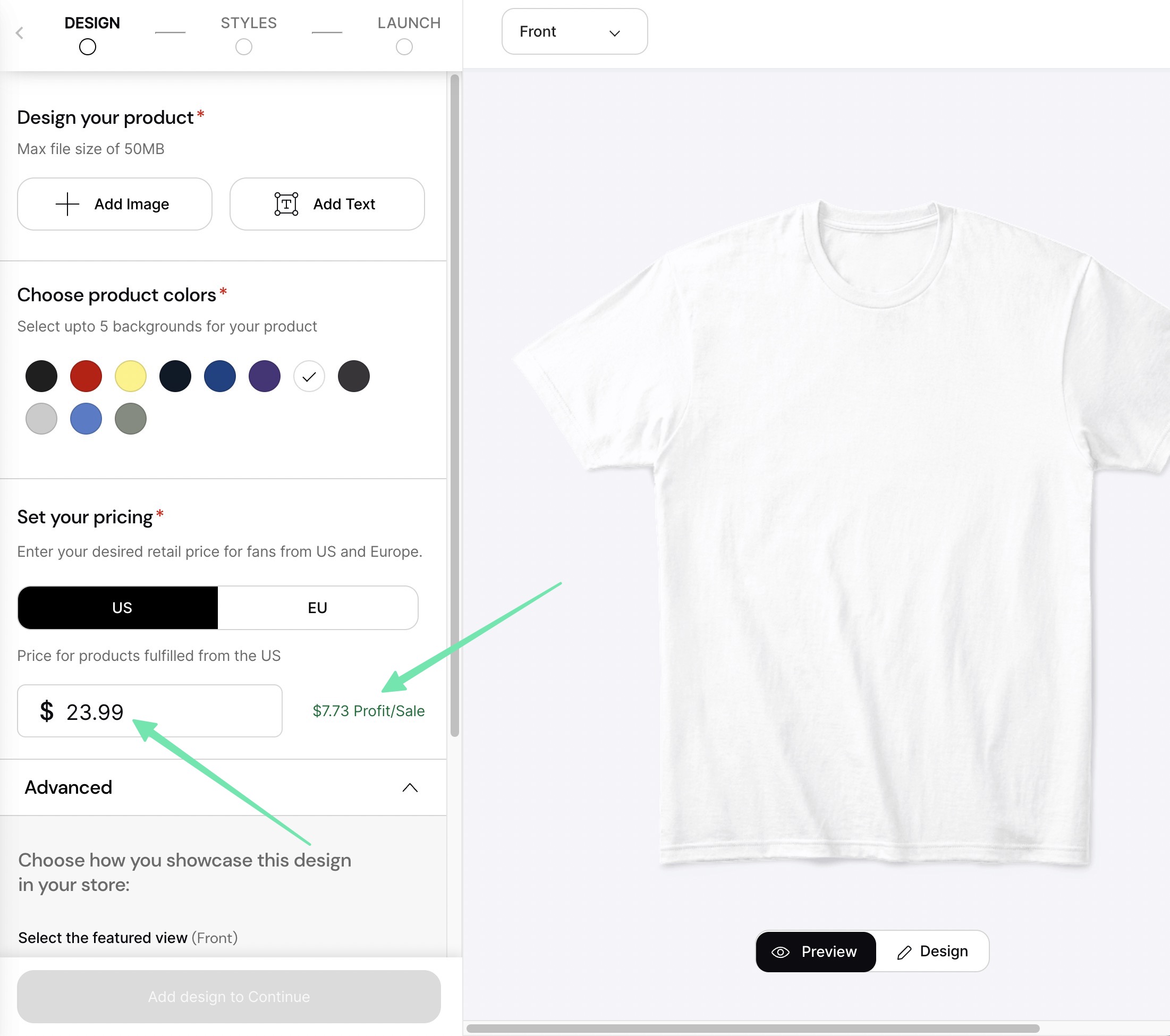
Payment processing fees are set to 0% for physical products on Teespring.
Digital products, on the other hand, have a processing fee of 10% + $0.40.
That’s a hefty fee, and it’s much higher than the credit card fees from Shopify. However, you’re not paying a monthly subscription with Teespring, so you save money upfront, especially if you’re not selling anything yet.
The Winner: Teespring
Teespring is entirely free to use until you start selling products. Even then, you’re making money with the sales, so all profits still go to you, the merchant. This makes it a much stronger proposition for keeping upfront costs low.
Shopify is affordable, especially considering the number of features you receive. When compared to Teespring, however, the monthly fees make it far pricier.
Keep in mind, that you should compare Teespring’s product costs with print-on-demand apps in Shopify, like Printful and Printify.
It’s the product costs that will really cut into your profits. It’s very possible, for example, that some Printify products + the Shopify subscription fee is cheaper than Teespring product costs. But it entirely depends on the item.
Furthermore, you may find that the digital product processing fee of 10% +$0.40 ends up being more money than the Shopify subscription + its 2.9% + $0.30 credit card rates. Only a calculation based on your store’s sales will provide that answer.
Teespring vs Shopify: Templates
When talking about templates, we’re referring to the pre-made online store designs provided for building a professional website without any coding knowledge. These are crucial for launching an online store in a matter of minutes, and minimizing development costs.
Shopify
Shopify offers 120+ themes for you to choose from when building an online store. They’re professional, beautiful designs with drag-and-drop editing tools so that you don’t have to manipulate any code.
As a result, merchants can launch an impressive ecommerce store within a matter of minutes.
There are 11 free themes, along with 112 premium themes, ranging from $200-$500 (one-time fee). Not only that, but each theme has several presets, which drastically change the designs.
This means Shopify actually has more like 350+ theme versions to construct a site.
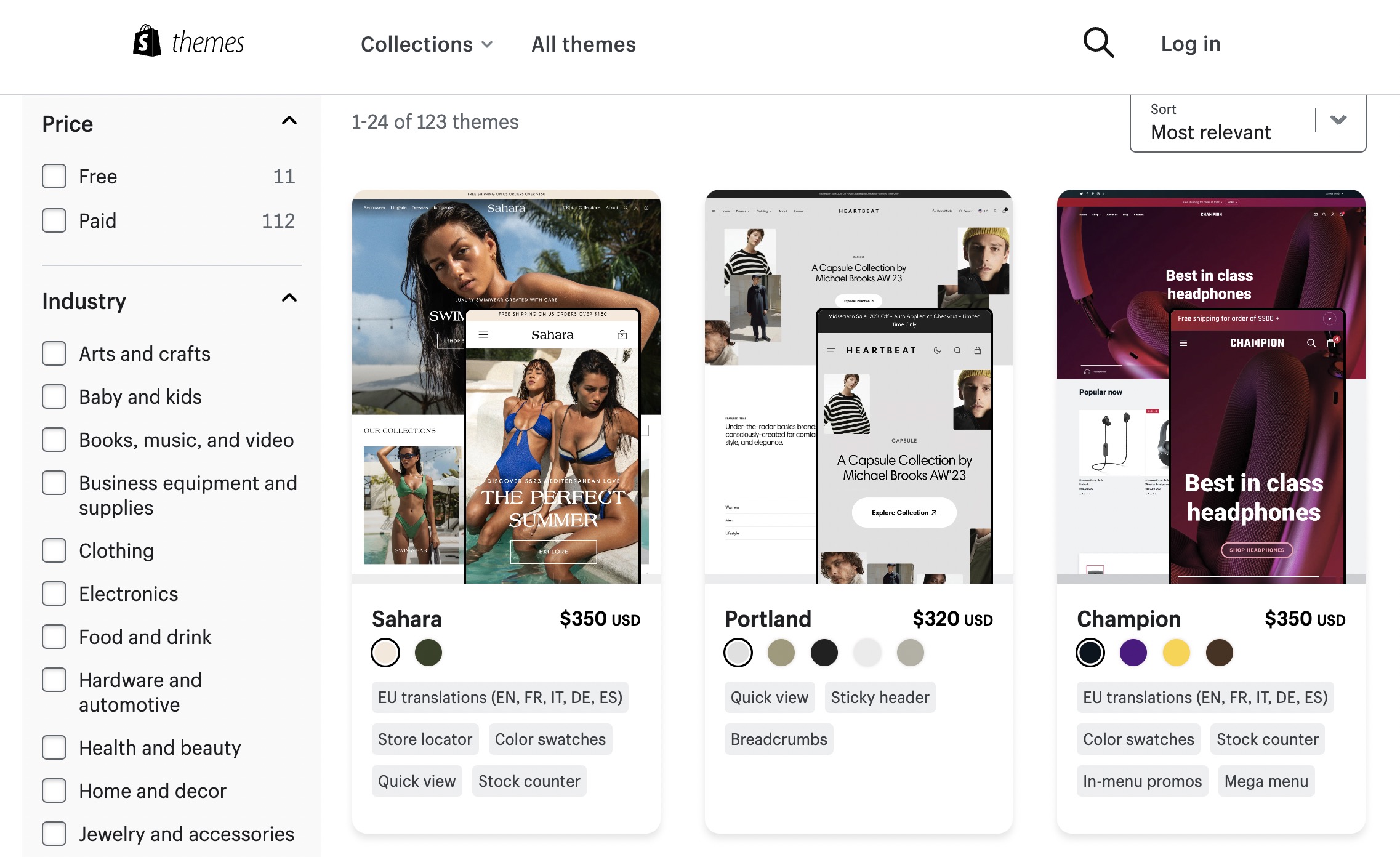
Categories for the themes include:
- Arts
- Books
- Clothing
- Hardware
- Home and decor
- Outdoor and garden
- Restaurants
- Services
- Toys and games
- Many more
From sticky headers to breadcrumbs, and quick views to stock counters, each theme comes with its unique set of features, so you must browse through to figure out the themes that work best for your business.
Overall, the themes from Shopify are easy-to-use, visually appealing, and affordable enough for building anything from a shop with 1,000 products to a print-on-demand store.
Teespring
Teespring is a marketplace before anything else. Yes, it offers custom domains for your online store, but every storefront within the Teespring marketplace is almost exactly the same, at least the general design.
That’s because Teespring only provides one prebuilt template.
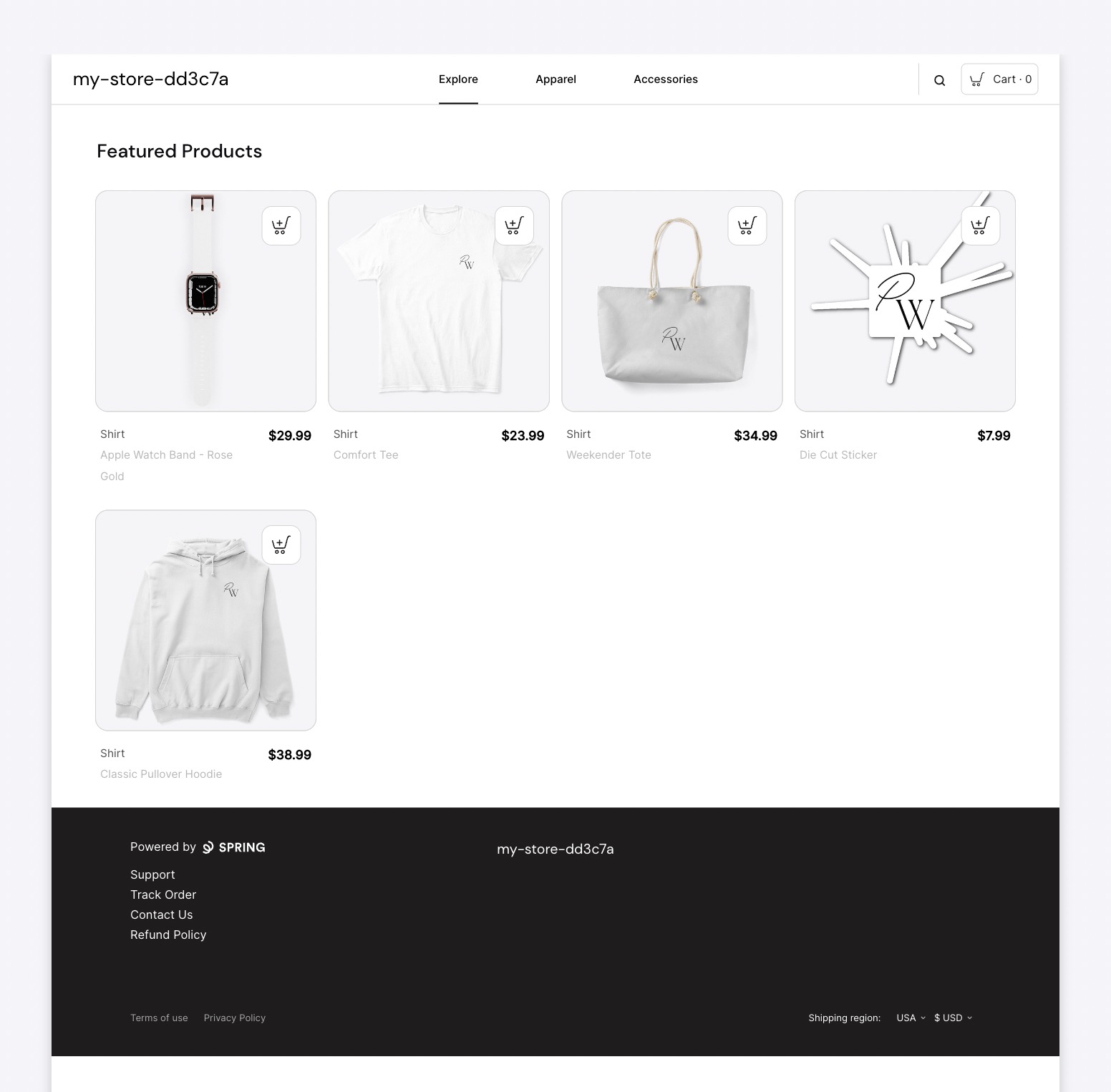
Having said that, merchants receive settings to customize:
- The logo
- Background colors
- Text colors
- Social links
- Navigation
- Hero banner
- Products
- Footer
- Button colors
As you can see, there are branding aspects to Teespring. However, comparing the template selection of Teespring to Shopify is a little unfair. Teespring strives to make design as simple as possible.
You get a standard storefront design and immediate access to the Teespring marketplace (where there are millions of people shopping). Shopify, on the other hand, provides templates for making an entirely unique ecommerce store.
Winner: Shopify
There’s no contest here. Shopify has over 120 storefront templates for all sorts of industries, and with various customization features. Teespring is easy to use, but you only get one template with a handful of customization settings.
You may, however, find that the extreme simplicity of Teespring is what’s needed for your brand, so don’t rule that out.
Shopify vs Teespring: SEO
Comparing the SEO of Shopify vs Teespring is a little tricky, since they work so differently. Take a look below to learn why.
Shopify
Shopify gives merchants a solid set of SEO settings for things like submitting sitemaps, listing products on Google Shopping, optimizing keywords, and automatically generating meta titles and descriptions for pages.
Not only that, but Shopify user have access to the Shopify App Store, which includes several search engine optimization apps for analyzing where you can improve for better search engine results.
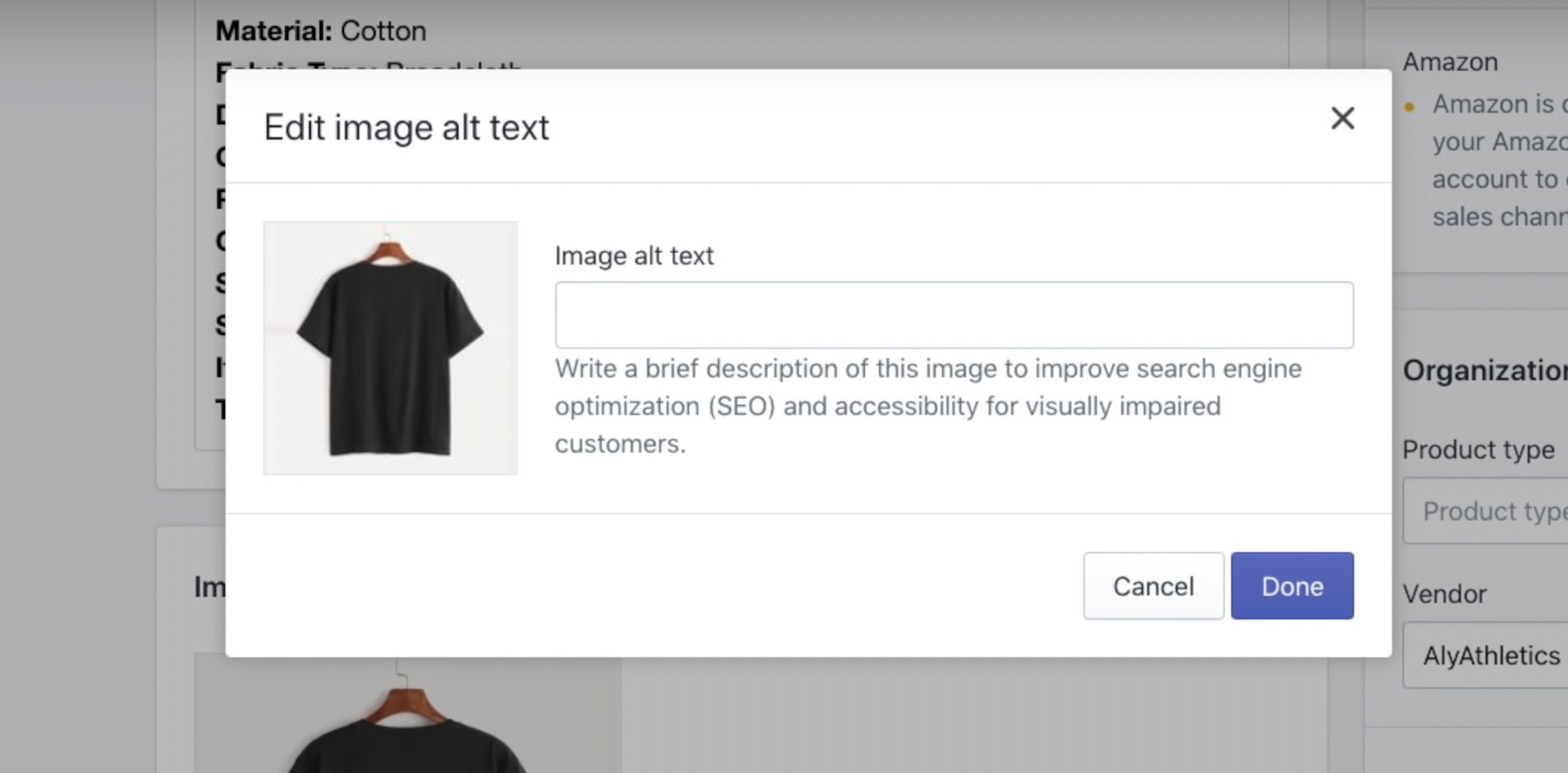
You’ll also notice that Shopify offers alt tags for images, boosting SEO potentially further.
Teespring
With Teespring, every merchant is part of its marketplace network. You start with a Teespring subdomain, and have the option to attach a custom domain. However, there are no SEO control tools available to sellers.
That’s because all the SEO work is done by Teespring. They’ve optimized their marketplace to show relevant products on Google, and push potential buyers to the right pages.
So, there’s not much to think about in terms of SEO, since you’re buying into the Teespring SEO infrastructure.
The Winner: Shopify
Some creators and individuals who run online stores will definitely find Teespring beneficial for SEO. After all, you don’t have to complete any work.
However, we like to see at least some SEO control, which Teespring lacks.
Shopify wins big in this category, but it also requires more manual work on your end. Yes, Shopify provides automated meta content, but that’s mostly all you get. You must go in to set alt tags for images. You need to optimize for keywords in your content. And you must use the tools to generate more customized meta data.
Shopify vs Teespring: Customer Support
Quality customer support from your ecommerce platform makes running an ecommerce business that much easier. It’s comforting knowing that you can reach out to a person through email or phone when your site goes down, or when there’s an issue processing payments.
Keep reading below to understand how Shopify and Teespring fare in the customer support realm.
Shopify
Known for its robust library of online resources, Shopify is no slouch when it comes to providing its users indirect customer support.
By indirect, we mean the type where you’re not speaking with an actual person. There’s nothing wrong with indirect support, especially if you’re more the type to research and solve your own issues.
Shopify offers:
- Community forums
- A help center with tutorials and videos
- A Shopify Expert center to hire freelancers and agencies to work on your site
- Multiple social media channels (like Facebook, Twitter, and YouTube) for reading articles and watching videos
- A blog with regular tips for building your brand
When it comes to direct, human customer support, Shopify offers support through the phone, email, a ticketing system, and a chat module in the Shopify dashboard.
From our tests and user experience, Shopify’s customer support team is knowledgeable about the platform, friendly, and willing to help when you contact them.
Teespring
With customers and sellers on both sides of its marketplace, Teespring actually provides two divisions of customer support. You’ll want to make sure you contact the Seller Support department to get someone to help you with a storefront.
For direct, human support, Teespring has live chat and email support options. Neither of these are available 24/7 (you must contact them during business hours, or wait until they get back). Shopify, on the other hand, provides much of its support at all hours.
As for indirect support, or the online resources available, Teespring has:
- An FAQs section
- A user community
- Blog posts to learn how to run your business
- Videos on YouTube
- An email newsletter
- A training center with articles in categories like “getting your first sale” and “promotional guides”
The Winner: Shopify
We’re happy with the amount of customer support from Teespring, but there’s no substitute for 24/7 support, and the fact that Shopify offers a phone line. Keep in mind, though, that Shopify tries its hardest to prevent you from calling that line, sending you through help center articles several times before showing you the phone number.
Which Platform Should You Use to Sell Merch?
It’s obvious that Shopify is the more feature-filled ecommerce platform, yet that’s not always what merchants want, especially if you’re a content creator looking for the utmost simplicity.
Here are our final recommendations based on when you should go with Shopify vs Teespring:
Go with Shopify if:
- You’re okay spending money on a monthly subscription in exchange for countless ecommerce features and a true online store
- You run a scaling online business that needs tools like abandoned cart recovery and gift cards
- It’s important to keep credit card fees down as much as possible
- You’re a content creator or influencer who wants more site design potential (in this case, you’d opt for a print-on-demand app like Printify or Printful)
- You want the option to choose from hundreds of templates and apps
- You’d prefer advanced control over site SEO
Go with Teespring if:
- You’d rather have no monthly fees in exchange for potentially higher credit card rates
- SEO, marketing, and website design is too involved for you (Teespring handles all of that for you)
- You want access to a marketplace with millions of built-in buyers
- You’re a content creator or influencer in need of a streamlined print-on-demand service
Have you tried Shopify or Teespring as a creator or entrepreneur? If so, share your thoughts on which one is better (Shopify vs Teespring) in the comments!
How to Sell with Teespring on Shopify
If you’re launching your own print on demand business, you don’t necessarily need to choose between using Shopify or Teespring. You can add the POD services available from Teespring from Shopify using a Teespring integrate option. Shopify offers a number of integrations with solutions like Printify, Printful, and Teespring, within the app marketplace.
All you need to do to get started is sign up for a Teespring account and create your Shopify account. Head to the Shopify app store, and search for Spring or TeeSpring. When you’ve installed the app, choose the “App” option on the left sidebar, and click on “Fulfillment by Teespring”.
You’ll need to log into your Teespring account to pull information about your created products over to your Shopify storefront. The two tools work relatively well together, allowing you to keep track of your customer database, checkout options, and POD products in one place.
For more insights into how you can use Shopify with POD solutions, check out our article on how to use Printful with Shopify.
Teespring vs Shopify: Verdict
Both Teespring and Shopify are excellent tools for business leaders. Shopify allows companies to create virtually any kind of online business or store, with flexible, scalable tools that suit a range of business needs.
Alternatively, Teespring is intended for those who want to develop their own custom products. The product design tools make it simple to create everything from unique hoodies and shirts to bags and accessories you can sell online.
If you’re looking for an easy way to create a POD business, you can combine the two solutions together, instantly expanding your profit and sales potential.






Comments 0 Responses